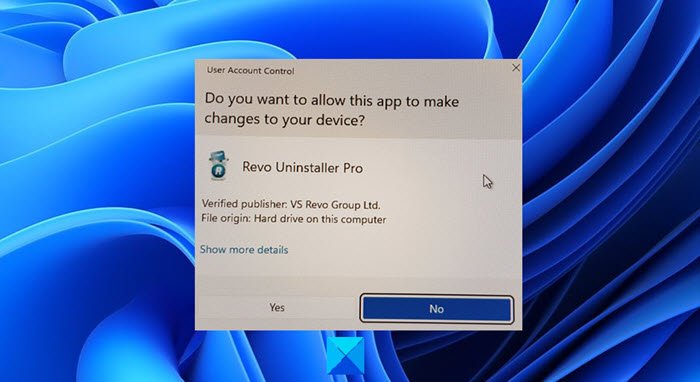User Account Control (UAC) in Windows 11/10
Do you want to allow this app to make changes message?
The User Account Control basically notifies you before changes are made to your PC – not all changes, but only those which require Administrator level permissions. These changes could have been initiated by the user, by the operation system, by genuine software – or even malware! Every time such an administrator-level change is initiated, Windows UAC will prompt the user for approval or denial. If the user approves the change, the change is made; in not, no changes are made to the system. Till such a time that the UAC appears, the screen may go dark. Broadly speaking, the following are some of the actions which may trigger a UAC prompt:
Install or Uninstall of applicationsChanging Firewall settingsInstalling Drivers & ActiveX controlsInstalling/Configuring Windows UpdateAdding/Removing/Changing user accounts/typesAccessing, Viewing or Changing another User’s files & foldersConfiguring Parental ControlsRunning the Task SchedulerRestoring backup system filesAnd even while changing UAC settings
Its default settings are: Whenever the UAC Consent Prompt appears and asks for your permission, you may have noticed that it darkens the screen and temporarily turns off the Aero interface – and it appears without the transparency. This is called Secure Desktop and is a security feature in Windows. The credential prompt is presented when a standard user attempts to perform a task that requires a user’s administrative access token.
The UAC elevation prompts are color-coded to be application-specific, enabling for immediate identification of an application’s potential security risk.
Read: UAC Yes button missing or grayed out.
Change User Account Control settings
If you wish, you can change User Account Control settings in Windows 8. You can change its behavior and decide how often or when all, the UAC should notify you. To do so, open Control Panel and select User Accounts.
Click on Change User Account Control settings. The settings box will open.
Use the vertical slider to change the settings. The changes you make will impact your security settings, so while its best to leave the User Account Control settings at its default, you should be aware of how the changes in the UAC setting will impact your Windows PC’s security. If you are using an accessibility device, such as a screen reader, Microsoft recommends that you choose either the Always notify or the Default – Notify me only when programs try to make changes to my computer UAC setting, since Assistive technologies work best with these two settings. Read: How to turn off or disable Secure Desktop in Windows.
Disable UAC using the Windows Registry
To do so, open regedit and navigate to the following key: Change the value of EnableLUA key, from its default 1 to Value data 0. This will disable the UAC. You can read more about all the UAC Group Policy Settings and Registry Key Settings here at TechNet.
Disable User Account Control for certain applications only
While you should not disable the UAC prompts for the whole computer, you may want to disable it for certain applications. Using the Microsoft Application Compatibility Toolkit and following the steps below, you can disable the UAC prompts for one or more specific applications that you trust. This will NOT disable the User Account Control feature for the whole computer. Have a great day! Check this if you cannot change User Account Control (UAC) settings.

